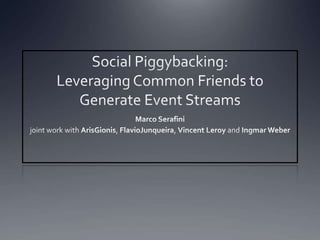
Social Piggybacking: Leveraging Common Friends to Generate Event Streams
- 2. Social Event Streams Background
- 3. Social event feeds Major feature - 70%of page views on Tumblr
- 4. Generating event streams Social networking system data store clients front-end (application logic) … user social data stores graph Two types of user actions Share anevent Generate a new event stream
- 5. Optimizations Materialized views, one per user Contain the user’s own events It can also contain events of the other users it follows We abstract away application-specific “relevance” filters All views contain all events stored in them All queries to a view return all events in the view VIEW EVENT Plato 12.00 “Having the shadow of an ideal sandwich” Hume 12.01 “I just feel a good taste in my mouth” Kant 12.02 “Dudes, just eat it and stop blabbering”
- 6. GOAL: Optimizing throughput Throughput of event stream Proportional to the amount of data being transferred Partitioning social graphs is impossible (or at least, very very hard) Existing approaches to optimize throughput Push-all Pull-all Hybrid
- 7. Pull-all Writes to your view only B Read from all your friends’ view A Simpler, good with frequent writes C WRITE from Alice Data stores READ from Charlie Data stores Alice Alice Client Client Alice Bob Charlie Bob Charlie Charlie
- 8. Push-all Write to all your friends’ views B Read from your view only A Good with frequent reads C WRITEs from Alice Data stores READ from Charlie Data stores and Bob Clients Alice Alice Client Alice Bob Charlie Bob Bob Charlie Charlie
- 9. Hybrid [Silberstein et. al., SIGMOD 2010] Per-edge choice between pull or push Uses Production Rate (PR) and Consumption Rate (CR) Minimum per-edge throughput cost If PR(A) < CR(B) If PR(A) ≥ CR(B) A B A B PUSH PULL A writes onto B’s view B reads from A’s view Cost: PR(A) Cost: CR(B)
- 10. Request schedule Social networking system data store clients front-end (application logic) … user social data stores graph Social graph contains the Request Schedule Per-edge Push or Pull Easy to integrate in existing system
- 11. Social Piggybacking Contribution
- 12. Idea: Social Piggybacking Two friends are likely to share many common friends Their views can be used as HUBS to prune edges SOCIAL PIGGYBACKING PUSH HUB A writes new events onto B’s view B PULL C reads events A by B and A from B’s view FREE EDGE! C Neither pull nor push
- 13. Social Dissemination Problem Inputs Social Graph Per-node Production and consumption rates Output: request schedulethat minimizes costs Each edge needs to be covered Can be through a hub, push or pull Requirements Bounded staleness Non-triviality
- 14. Analysis All admissible request schedule are s.t., for each edge The edge is served directly, using a push or a pull, or The edge is served through a hub. Any other schedule is not admissible The Social Dissemination problem is NP-hard
- 15. Nosy: A Simple Heuristic Nosy looks for hubgraphs Cost with Piggybacking : PR(X) + CR(Y), cross edges free
- 16. Nosy Phase 1 Add elements to X sets X For each edge (w, y) Build the largest hubgraph(X, w, y) Piggybacking cost: PR(X) + CR(y) X w y Cross edges X ->y are free Piggyback if cheaper than hybrid
- 17. Nosy Phase 2 Add elements to Y sets X Y For each (w, y) Let Xybe producers of y that push to w already X X w y Piggybacking cost: CR(y) Cross edges Xy ->y are free Piggyback if cheaper than hybrid
- 18. Experiments Flickr and Twitter graphs
- 19. Experiments Twitter (Aug 2009) and Flickr (Apr 2008) social graphs Samples using random walks, which preserve graph properties Average sizes Flickr: 4 k nodes, 112 k edges Twitter: 25 k nodes, 158 k edges Production and consumption rates are generated write:read ratio is 1:5 PR (resp. CR) increases logarithmically with out- degree (resp. in-degree)
- 20. Metrics and Results Metric Improvement overhybrid optimization (baseline) Gain(A) = Cost(BASE) / Cost(A) – 1 Results 1. Nosy exploits the community structure 2. It works well under a variety of parameters
- 21. Clustering Coefficient After sampling, we keep only a fraction s of edges B+ is a trivial extension of Baseline Lock push edges Pull edges that can be served using hubs are free More clustering, more gain for Nosy but not for B+
- 22. Varied Workload Significant gains Asymptotically, i.e. with all reads, the per-edge push- based solution is optimal so the gain tends to zero
- 23. Effect of Colocation As the system size grows, the gains reach their maximum For very small systems there is little communication so little room for improvements
- 24. Conclusions Social Piggybacking is a very promising approach Baseline has up to 2.4 times higher throughput cost Easy to integrate in existing systems Next steps Run on full social graphs Evaluate throughput gain on actual social networking system
